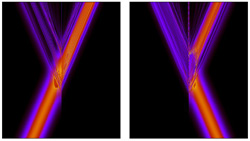One-way Light
Ordinarily, waves don’t play favorites with direction–they flow the same way from right to left as from left to right. But a theoretical paper in the 22 April Physical Review Letters suggests a way to make finicky light that flows freely in one direction but not the other. The idea is to use an asymmetric arrangement of so-called nonlinear materials, in which the wave’s amplitude affects its speed. The device could find applications in areas from quantum computers to soundproofing.
Researchers have long sought a way to make light waves prefer to travel in a particular direction, the first step in creating a sort of diode for light. But this effect is forbidden by a hundred year old rule called the reciprocity theorem, which states that identical waves in a linear medium–where waves follow simple, textbook rules–will behave the same way no matter where they came from.
Previous attempts to defy the reciprocity theorem used periodic nanostructures called photonic crystals to build a light diode. But that system relied on the crystal generating light with twice the frequency of the original wave. That so-called second harmonic could travel only one direction–but the original wave was unaffected, letting much of the light pass right through the barrier.
Another workaround is to use nonlinear materials, such as specialized plastics or glasses in which the intensity of light affects its speed and other properties. “When you introduce nonlinear interactions and forces, many of the intuitions we have are no longer valid,” says Stefano Lepri of the Italian National Research Council Institute for Complex Systems in Florence. “We can use this nonlinear interaction to break this fundamental result of reciprocity theory.”
Lepri and coauthor Giulio Casati of the University of Insubria in Italy modeled waves using the Discrete Nonlinear Schrödinger (DNLS) equation, the simplest model that supports nonlinear waves. The team chose this equation because it is well studied in contexts ranging from optics to atomic physics, and because it is possible to find an exact solution for a single wave, Lepri says.
The researchers imagined a wave travelling in one dimension through a series of thin layers of a linear medium (such as ordinary glass for light waves) with two nonlinear sheets sandwiched in the middle. They applied the DNLS equation with slightly different parameters for these two layers, making the arrangement asymmetric, and used a linear equation for the other layers.
The solutions showed that waves are best transmitted when their frequency matches a “resonance” value for the nonlinear layers, but as with many nonlinear systems, this frequency depends on the wave’s amplitude. However, the dependence is different for oppositely-directed waves because of the asymmetric set-up. So for some amplitudes, if identical waves come from opposite directions, only one of them can have the right combination of frequency and amplitude to be fully transmitted, while the other is largely reflected. They found similar results with larger numbers of nonlinear layers.
Because Lepri’s system doesn’t rely on harmonics, as the photonic crystal system did, it can transmit light much more efficiently, says Panayotis Kevrekidis of the University of Massachusetts at Amherst. The amount of light that makes it through depends on the properties of the nonlinear material, which means you can tune the system to block some or all of the light. “What the nonlinear medium allows you to do is create perfect transmission,” Kevrekidis says.
If built, the system could help trap light in future quantum computers that do calculations with light, says Lepri. An analogous device for sound waves could be used to perfectly soundproof a room. Kevrekidis thinks physicists won’t have to wait long to see choosy light in the lab. “People already have setups [in their labs] that they can tweak to actually see this,” he says.
–Lisa Grossman
Lisa Grossman is a freelance science writer.
More Information
One-way Mirror for Sound Waves (Focus, 2009)





